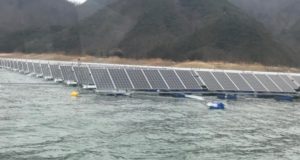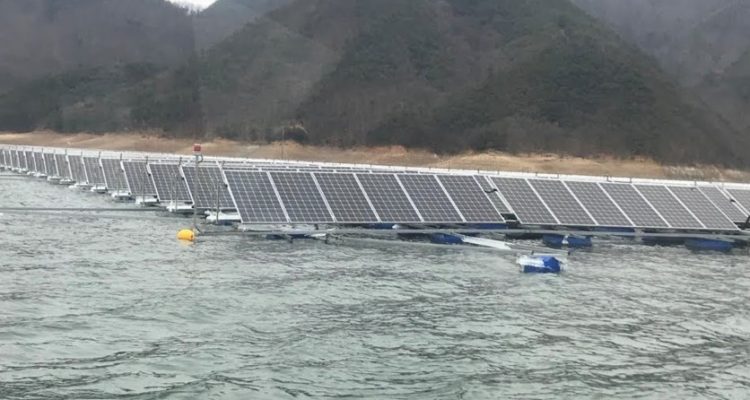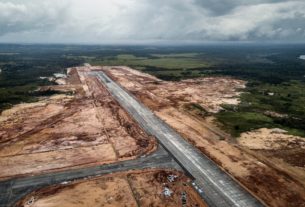 Saving the Mekong With Floating Solar Power Solution
Saving the Mekong With Floating Solar Power Solution
05 December 2019
By: David Brown, Mongabay
For two decades or more, alarms have been sounding for the Mekong Delta. It is being hammered by climate change, by a proliferation of upstream dams, by unsustainable and inappropriate farming practices, by greed and political expediency. The punishment the Delta’s taking has been well reported, first in scholarly papers, then in specialized publications and appeals by NGOs.
Now there is a consensus: an environmental disaster is inexorably unfolding over 75,000 square kilometers of famously fertile lowlands in Vietnam and Cambodia, home to some 35 million farmers and fishermen. Major media are publishing melancholy obituaries for the Mekong that once was.
And yet, in the autumn of a year when the Mekong flood pulse came later than ever, there’s reason to believe that disruptive technology and market forces could spare the Mekong Delta more irreversible disturbance to its hydrology and ecosystems. It boils down to this: low-cost, easily scalable solar power generating technologies have destroyed the economic case for additional hydroelectric power projects.
The Solar Solution
A floating solar power generating system, the first in Southeast Asia, was deployed this year on a reservoir in south-central Vietnam. The 47.5 megawatt Da Mi project was financed by an Asian Development Bank loan. Its builder-operator is a subsidiary of Vietnam’s national power company, EVN. In the west, where power needs are considerably higher, 1 megawatt is considered capable of lighting 165 homes.
Da Mi is not a heavily subsidized demonstration project but instead a very sensible response to market incentives. To jump-start a shift toward solar power generation, Vietnam’s government instructed EVN, the national power company, to pay 9.35 US cents per kilowatt-hour for 20 years to any project brought online by June 30, 2019. For the operators of the Da Mi hydroelectric power plant, the economics of integrating a solar system with the existing dam were compelling. The 50-hectare (124 acre) array of solar panels, each tilted to a precisely calculated angle to maximize solar gain, began supplying power to Vietnam’s national grid in May.
Because the cost of solar photovoltaic panels has fallen so sharply in the past decade, and because utility-scale installations can be completed in a matter of months, these projects are now competitive with coal, gas, hydro or nuclear. Panel fabrication and battery storage costs are widely expected to fall much further. Floating solar power arrays constructed on the reservoirs of existing hydropower dams are particularly cost-effective; there are no site acquisition costs, they are simple to scale up as demand increases, transmission infrastructure is already in place, and power generation can be optimized by relying chiefly on photovoltaic power during daylight hours and on hydropower at night.
Floating solar power systems are being written into the energy master plans of Singapore, Thailand, Indonesia and the Philippines as well as Vietnam, and into the calculations of investment banks.
Floating solar power on a larger scale, 400 MW peak power, also figures as an alternative to plans to build a massive dam and power plant on the Mekong in eastern Cambodia. By 2014, growing concern over the proposed Sambor Dam’s ecological impact persuaded the Cambodian government to commission a study of alternative designs.
The study, delivered three years later by the California-based Natural Heritage Institute, declared the project an ecological disaster that no set of environmental mitigation features could overcome. Remarkably, NHI found that an entirely different alternative, floating solar photovoltaic arrays on the nearby Lower Se San 2 reservoir, could deliver electricity to the Cambodian grid at lower life-cycle cost than any permutation of the Sambor scheme, and without significant environmental impacts.
Purely on economic and financial grounds, the Sambor hydro plan ought to be dead. However, Cambodia is a country in the early stages of industrialization. Its power needs are growing by 15-20 percent annually. The country is also a de facto ally of China, on which it counts to deter efforts by Vietnam or Thailand to push it around. Official corruption is rife. Complaints from citizens don’t seem to impress the Phnom Penh authorities. If Chinese state banks remain willing to lend Chinese companies the cash needed to build Sambor and another controversial dam further upstream at Stung Treng, will Phnom Penh have the sense to refuse it?
Laos still dreams of getting rich from power exports. Although it too is considering an NHI floating solar proposal, neither the ever-more-dismal economics of hydropower nor accumulating debts to Sinohydro and other Chinese contractors have yet dimmed Vientiane’s enthusiasm to host circa 200 power-producing dams. Nor have its neighbors yet backed away from promises to import large amounts of power from Laos. Thailand has reportedly committed to raise its import of power from Laos to 9000 MW by 2025 from the present 4000 MW or so. Vietnam meanwhile has plans to take 5000 MW by 2030; and Cambodia has just promised to take 2400 MW beginning in 2024 from coal-fired power plants now under construction in Laos.
In Vietnam, which has left hardly a river within its own borders undammed, expert opinion has now turned sharply against hydroelectric projects on the Mekong and its tributaries. As often reported in the Vietnamese vernacular press, dams in China, on tributaries of the Mekong in Vietnam’s highlands, and on river after river in Laos have throttled the annual flow of nutrient-laden silt to Vietnam’s Mekong Delta provinces and depleted fishing stocks there. Ironically, an engineering and construction firm with close government ties, PetroVietnam Power, has announced that it will begin construction of a US$2 billion, 1400 MWp dam and power plant on the Mekong just above Luang Prabang in 2020; a Thai firm, Chart Karnchang, is expected to be a major subcontractor.
Cambodia and its upstream neighbor, Laos, are willing to take foreign aid aimed at greening up their power grids, but neither feels much obligation to reduce an admittedly tiny carbon footprint. In short, though generating power from coal or damming rivers is fast becoming uneconomic, the old ways still have considerable momentum.
Scaling up
Netting out these cross-currents, it’s by no means certain that good technology will drive out bad, particularly at a scale that meets mainland Southeast Asia’s fast-growing power demand. Still, environmentalists can dream.
One of them is Vietnamese-American engineer Long Pham. Since 1995, Long’s Viet Ecology Foundation has fostered dialogue between experts in the Vietnamese refugee diaspora and counterparts in Vietnam. Now he is urging Cambodian policymakers to consider his vision of a 28.5 GWp floating solar energy plant on Southeast Asia’s largest lake, the Tonle Sap.
Long’s “Sun on the Lake” project is bold in its scope: he proposes a floating installation that is scaled up year after year in step with Cambodia’s growing power needs until it is 590 times the size of the DaMi solar generating plant in Vietnam mentioned earlier, 70 times larger than the solar plant proposed by NHI on Cambodia’s Lower Se San 2 reservoir as a partial alternative to the Sambor hydro project, and the equivalent of 47 average-sized coal-powered generating plants.
The Tonle Sap is an ideal location for a floating solar power array: it’s one of the sunniest places in Southeast Asia. Panels tilted south at a 14-degree angle will receive, on average, 2034 kilowatt hours of irradiation per square meter per year.
Long forsees that a floating solar power system on the Tonle Sap can be built out in 34 square kilometer annual increments to keep pace with Cambodia’s thirst for power. He assumes that the cost of solar panels, currently circa $800/kilowatt hour, will decline by 2 percent per year and battery storage costs will also decline. Adding also operation and maintenance costs and the cost of connection to Cambodia’s national grid, Long calculates that the floating solar array could meet all of Cambodia’s energy demand from 2020 to 2045 and likely beyond, for a levelized cost of 7.73 US cents per kilowatt-hour. That’s comparable to the cost of building more dams on the Mekong mainstream, and less than half what Cambodian consumers now pay for electricity.
When avoided losses – the preservation of inland fisheries and agricultural land, and the creation of jobs for Cambodia’s riparian population – are considered, the levelized cost of power from the Sun on the Lake project falls by Long’s calculation to only 4.93 cents per kilowatt-hour.
Long does not suggest who’s going to provide the US$31 billion he estimates will be needed to build the 330 square kilometer Tonle Sap project. Will Chinese banks be as keen to fund a huge floating solar array as they have been to lend to hydroelectricity projects? That’s entirely conceivable. China’s factories produce more than 60 percent of the global supply of solar panels and its engineers have plenty of experience building solar farms.
“It would be a high-profile opportunity for the Chinese to show their neighbors that they are good big brothers,” says Long.
Existing hydropower plants a viable alternative
If not China, perhaps Western development banks and contractors could be persuaded to step up to this unique opportunity to avert ecological catastrophe and profit from doing so. In the near term, however, they’ll more likely focus on a floating solar concept proposed by NHI in July 2018, which would leverage existing hydropower plants and their reservoirs – five in Cambodia and nine in Laos – to produce an additional five gigawatts of power.
Co-locating floating solar with existing hydropower plants, explained NHI CEO Greg Thomas, roughly doubles power output and reduces its variability. This is because the two modes of power generation are complementary. During the day, the hydropower turbines can be ramped down except when needed to balance dips in solar output induced by passing clouds. At night, taking advantage of the water added to the reservoirs during the day, the turbines can be run at a higher speed.
Solar retrofit of existing dams, Thomas adds, would enable Laos to meet its ambitious power export targets by building fewer dams, bringing additional power online far faster and at a substantially lower cost.
Finding friendly decision-makers
Will the decision-makers in Vientiane and Phnom Penh forego the hydropower projects that they endorsed many years ago, before environmental impacts were properly understood and when wind and solar power alternatives were hardly conceivable?
In Cambodia, Prime Minister Hun Sen and a few trusted aides monopolize decision-making. The national power development plan, about to be updated, will likely be once again a grab-bag of possibilities. Chronic power shortages are a brake on Cambodia’s economic growth, and conventional wisdom has it that what gets built will be whatever somebody is willing to finance at power prices set by the national power company, EDC. The urgency of getting more power onto the grid should favor solar, especially floating solar, but for that to become a big part of the solution, EDC will have to improve its grid stabilization capability.
As utility scale power generation from wind and solar, floating or not, gains traction in Thailand and Vietnam, the Lao government will face difficult choices. It must face up to the very real possibility that the fast-falling cost of generating power within their own borders will induce both Thailand and Vietnam to walk away from commitments to purchase power produced by the would-be “Battery of Southeast Asia.” In that case, further hydropower development on the Mekong and its tributaries will no longer be financeable.
David Brown is a former US diplomat with extensive experience in Vietnam and a regular contributor to Asia Sentinel. This is reprinted from Mongabay, a US-based nonprofit conservation and environmental news platform.
Source: https://www.asiasentinel.com/econ-business/mekong-floating-solar-power/

